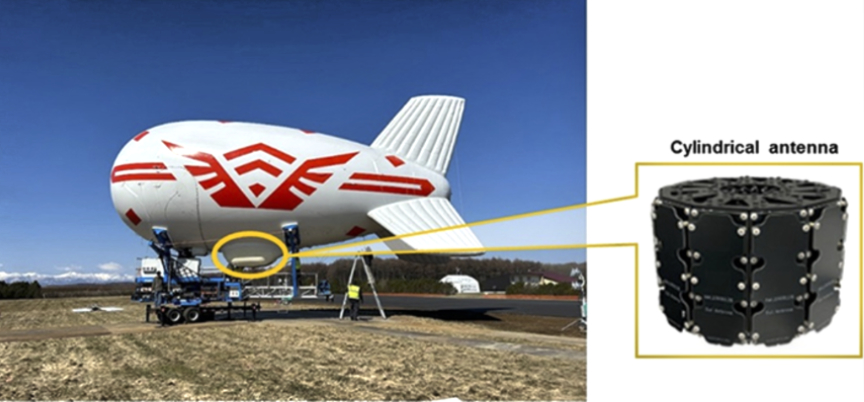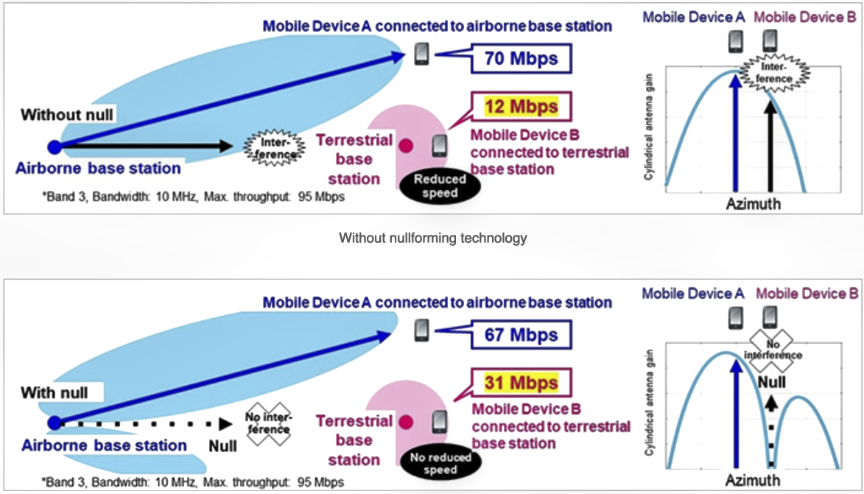
SoftBank Corp. has successfully conducted a field trial using the company’s cylindrical antenna1 for High Altitude Platform Station (HAPS) stratospheric-based wireless communication systems at Hokkaido Spaceport, Taiki Town, in Hokkaido, Japan.
The trial successfully demonstrated the use of nullforming technology2 to achieve spectrum sharing between HAPS and a terrestrial base station. SoftBank is currently conducting R&D on foundational technologies with the aim of providing stable and high-quality communication networks that use HAPS.
This field trial was conducted as part of SoftBank’s R&D initiatives to enhance communication technologies used with HAPS. Patents are pending for some of the nullforming technologies that were used in this trial.
Part of this field trial was based on the “Dynamic Area Optimization Technology Using CPS for Aerial Platforms” (JPJ012368C05701)3 research project, which was selected and commissioned by the National Institute of Information and Communications Technology (“NICT”) in Japan for its “Beyond 5G R&D Promotion Project” in 2022.
SoftBank is conducting R&D on spectrum sharing to enable the deployment of communication services that use the same frequency for HAPS and terrestrial base stations4. While assigning dedicated frequencies to HAPS and terrestrial base stations separately would eliminate radiowave interference and enable the provision of high-quality communication networks, doing this also means the utilization of multiple frequencies, which are finite.
Accordingly, SoftBank is considering the use of cylindrical antennas as antennas for “service links,” which handle data transmission and reception between HAPS and communication devices, and is developing a nullforming technology, which significantly suppresses radiowave emissions in specified directions to suppress interference.
By preventing interference, it is possible to achieve spectrum sharing between HAPS and terrestrial base stations, and thereby use spectrum effectively.

In this field trial, SoftBank placed a terrestrial base station within the communication area of a high-altitude tethered aerostat5 equipped with a cylindrical antenna (“airborne base station”). Mobile Device A was placed within the communication area of the airborne base station while Mobile Device B was positioned in a geographically close location within the communication area of the terrestrial base station.
The same frequency was used for both the airborne base station and the terrestrial base station, and the communication speeds of Mobile Device A and Mobile Device B were measured based on whether nullforming technology was applied. Furthermore, when comparing communication speeds based on the presence or absence of nullforming technology, the radiowaves from the airborne station were halted, and the communication speeds of Mobile Device B were measured in an environment where there was no radiowave interference from the terrestrial base station.
Through this field trial, it was observed that the application of nullforming technology improved the communication speeds of Mobile Device B without significantly degrading the communication speed of Mobile Device A. Furthermore, by applying nullforming technology, interference between both base stations was reduced, and it was confirmed that Mobile Device B achieved communication speeds equal to those in an environment without radio interference when the radiowaves from the airborne base station were halted to prevent interference.
The field trial confirmed the feasibility and effectiveness of spectrum sharing between airborne base stations and terrestrial base stations using nullforming technology in actual outdoor environments, and the trial represents a significant achievement for enabling the effective usage of spectrum in networks that use existing base stations and HAPS.
Using the knowledge and data obtained through this field trial, SoftBank will continue to work to realize the practical use of HAPS and utilize spectrum efficiently.


To learn more about SoftBank’s HAPS initiatives, please visit this website.
1 For more information, please see this notice from SoftBank dated September 2, 2021: SoftBank Corp. and HAPSMobile Accelerate High Altitude Platform Station (HAPS) R&D to Provide Stable and High-quality Connectivity for Future Commercial Services
2 A technology that significantly suppresses radiowave emissions in a specific direction to prevent interference.
3 Research project for R&D related to enhancing aerial platforms and optimizing their network coverage within covered areas on an operational basis, with a view to realizing Non-Terrestrial Networks (NTN) that achieve wide-area coverage from aerial platforms. CPS is an abbreviation of Cyber Physical Systems.
4 For more information, please see this press release from SoftBank dated December 28, 2023: SoftBank Corp.-led Proposal to Expand Spectrum Use for HAPS Base Stations Agreed at World Radiocommunication Conference 2023 (WRC-23)
5 For more information, please see this press release from SoftBank dated June 22, 2022: SoftBank Corp. Successfully Tests High-altitude Tethered Balloon Base Station System that Utilizes Footprint Fixation Technology
